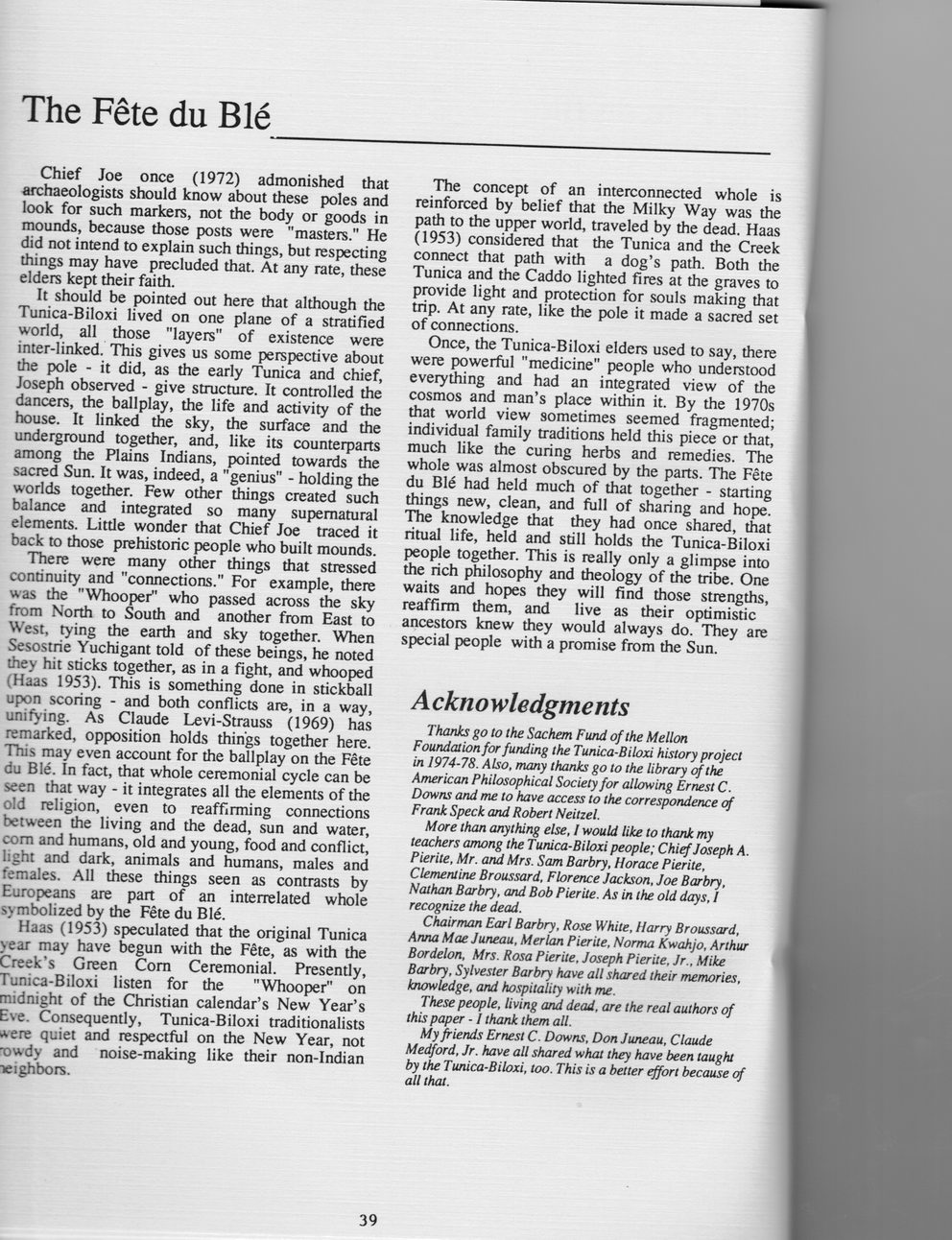This text was obtained via automated optical character recognition.
It has not been edited and may therefore contain several errors.
The Fete du Ble Chief Joe once (1972) admonished that archaeologists should know about these poles and look for such markers, not the body or goods in mounds, because those posts were "masters." He did not intend to explain such things, but respecting things may have precluded that. At any rate, these elders kept their faith. It should be pointed out here that although the Tunica-Biloxi lived on one plane of a stratified world, all those "layers" of existence were inter-linked. This gives us some perspective about the pole - it did, as the early Tunica and chief, Joseph observed - give structure. It controlled the dancers, the ballplay, the life and activity of the house. It linked the sky, the surface and the underground together, and, like its counterparts among the Plains Indians, pointed towards the sacred Sun. It was, indeed, a "genius" - holding the worlds together. Few other things created such balance and integrated so many supernatural elements. Little wonder that Chief Joe traced it back to those prehistoric people who built mounds. There were many other things that stressed continuity and "connections." For example, there was the "Whooper" who passed across the sky from North to South and another from East to West, tying the earth and sky together. When Sesostrie Yuchigant told of these beings, he noted they hit sticks together, as in a fight, and whooped (Haas 1953). This is something done in stickball upon scoring - and both conflicts are, in a way, unifying. As Claude Levi-Strauss (1969) has remarked, opposition holds things together here. This may even account for the ballplay on the Fete du Ble. In fact, that whole ceremonial cycle can be seen that way - it integrates all the elements of the old religion, even to reaffirming connections between the living and the dead, sun and water, com and humans, old and young, food and conflict, light and dark, animals and humans, males and females. All these things seen as contrasts by Europeans are part of an interrelated whole symbolized by the Fete du Ble. Haas (1953) speculated that the original Tunica year may have begun with the Fete, as with the Creek’s Green Com Ceremonial. Presently, Tunica-Biloxi listen for the "Whooper" on midnight of the Christian calendar’s New Year’s Eve. Consequently, Tunica-Biloxi traditionalists *ere quiet and respectful on the New Year, not nowdy and noise-making like their non-Indian leighbors. The concept of an interconnected whole is reinforced by belief that the Milky Way was the path to the upper world, traveled by the dead. Haas (1953) considered that the Tunica and the Creek connect that path with a dog’s path. Both the Tunica and the Caddo lighted fires at the graves to provide light and protection for souls making that trip. At any rate, like the pole it made a sacred set of connections. Once, the Tunica-Biloxi elders used to say, there were powerful "medicine" people who understood everything and had an integrated view of the cosmos and man’s place within it. By the 1970s that world view sometimes seemed fragmented; individual family traditions held this piece or that, much like the curing herbs and remedies. The whole was almost obscured by the parts. The Fete du B16 had held much of that together - starting things new, clean, and full of sharing and hope. The knowledge that they had once shared, that ritual life, held and still holds the Tunica-Biloxi people together. This is really only a glimpse into the rich philosophy and theology of the tribe. One waits and hopes they will find those strengths, reaffirm them, and live as their optimistic ancestors knew they would always do. They are special people with a promise from the Sun. Acknowledgments Thanks go to the Sachem Fund of the Mellon Foundation for funding the Tunica-Biloxi history project in 1974-78. Also, many thanks go to the library of the American Philosophical Society for allowing Ernest C. Downs and me to have access to the correspondence of Frank Speck and Robert Neitzel. More than anything else, I would like to thank my teachers among the Tunica-Biloxi people; Chief Joseph A. Pierite, Mr. and Mrs. Sam Barbry, Horace Pierite, Clementine Broussard, Florence Jackson, Joe Barbry, Nathan Barbry, and Bob Pierite. As in the old days, I recognize the dead. Chairman Earl Barbry, Rose White, Harry Broussard, Anna Mae Juneau, Merlan Pierite, Norma Kwahjo, Arthur Bordelon, Mrs. Rosa Pierite, Joseph Pierite, Jr., Mike Barbry, Sylvester Barbry have all shared their memories, knowledge, and hospitality with me. These people, living and dead, are the real authors of this paper -1 thank them all. My friends Ernest C. Downs, Don Juneau, Claude Medford, Jr. have all shared what they have been taught by the Tunica-Biloxi, too. This is a better effort because of all that.

Native Americans The-Tunica-Biloxi-Tribe-its-Culture-and-People-(48)